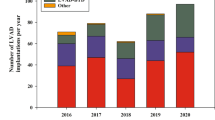Abstract
Purpose of review
The benefit of left ventricular assist devices in patients dependent on inotropes or temporary mechanical support is clear. There is a large population of advanced heart failure patients who are ambulatory and not dependent on inotropes, but in whom mortality remains high. We review the limited evidence regarding the benefits and risks of LVADs in this population.
Recent findings
The REVIVE-IT trial, which aimed to study the use of LVADs in patients who are less sick and do not meet current FDA-indications, was suspended due to lack of equipoise in the setting of a spike in pump thromboses. The ROADMAP trial was a non-randomized study that compared HMII DT LVAD to optimal medical therapy in ambulatory patients who were not on inotropes. Patients in the LVAD arm were more likely to reach the primary endpoint, being alive at 12 months with an improvement in 6-min walk distance. There was a quality of life and functional capacity advantage in the LVAD arm, but at a cost of increased adverse events.
Summary
The use of LVADs in ambulatory, non-inotrope dependent patients should be carefully considered, and risks and benefits should be discussed with patients before they clinically deteriorate.




Similar content being viewed by others
References
Papers of particular interest, published recently, have been highlighted as: • Of importance •• Of major importance
Rose EA, Gelijns AC, Moskowitz AJ, et al. Long-term use of a left ventricular assist device for end-stage heart failure. N Engl J Med. 2001;345:1435–43.
Slaughter MS, Rogers JG, Milano CA, et al. Advanced heart failure treated with continuous-flow left ventricular assist device. N Engl J Med. 2009;361:2241–51.
Kirklin JK, Naftel DC, Pagani FD, et al. Seventh INTERMACS annual report: 15,000 patients and counting. J Heart Lung Transplant. 2015;34:1495–504.
Stevenson LW, Pagani FD, Young JB, et al. INTERMACS profiles of advanced heart failure: the current picture. J Heart Lung Transplant. 2009;28:535–41.
Estep JD, Starling RC, Horstmanshof DA, et al. Risk assessment and comparative effectiveness of left ventricular assist device and medical management in ambulatory heart failure patients: results from the ROADMAP study. J Am Coll Cardiol. 2015;66:1747–61. This study is the only prospective trial to date to directly compare the use of LVAD vs. medical management in ambulatory non-inotrope dependent patients (i.e. INTERMACS profiles 4-7).
Rogers JG, Boyle AJ, O'Connell JB et al. Risk assessment and comparative effectiveness of left ventricular assist device and medical management in ambulatory heart failure patients: design and rationale of the ROADMAP clinical trial. Am Heart J 2015; 169:205-210 e220.
Boyle AJ, Ascheim DD, Russo MJ, et al. Clinical outcomes for continuous-flow left ventricular assist device patients stratified by pre-operative INTERMACS classification. J Heart Lung Transplant. 2011;30:402–7.
Grady KL, Naftel D, Stevenson L, et al. Overall quality of life improves to similar levels after mechanical circulatory support regardless of severity of heart failure before implantation. J Heart Lung Transplant. 2014;33:412–21.
Jorde UP, Kushwaha SS, Tatooles AJ, et al. Results of the destination therapy post-food and drug administration approval study with a continuous flow left ventricular assist device: a prospective study using the INTERMACS registry (Interagency Registry for Mechanically Assisted Circulatory Support). J Am Coll Cardiol. 2014;63:1751–7.
Kirklin JK, Naftel DC, Pagani FD, et al. Sixth INTERMACS annual report: a 10,000-patient database. J Heart Lung Transplant. 2014;33:555–64.
Stewart GC, Teuteberg J.J., Kittelson M et al. INTERMACS profiling identifies risk of death or VAD among medically-managed advanced heart failure patients. J Heart Lung Transplant 2013:S133.
Ambardekar AV, Forde-McLean RC, Kittleson MM et al. High early event rates in patients with questionable eligibility for advanced heart failure therapies: Results from the Medical Arm of Mechanically Assisted Circulatory Support (Medamacs) Registry. J Heart Lung Transplant 2016. This study shows a high mortality at less than one year in INTERMACS 4-7 heart failure patients who are deemed to have poor eligbility for transplant or LVAD.
Stewart GC, Mountis MM, Kittelson MM. Early reassessment of ambulatory advanced heart failure detects high-risk trajectories along a dynamic baseline. J Heart Lung Transplant. 2015;34:S56.
Baldwin JT, Mann DL. NHLBI’s program for VAD therapy for moderately advanced heart failure: the REVIVE-IT pilot trial. J Card Fail. 2010;16:855–8.
Starling RC, Moazami N, Silvestry SC, et al. Unexpected abrupt increase in left ventricular assist device thrombosis. N Engl J Med. 2014;370:33–40.
Kirklin JK, Naftel DC, Pagani FD, et al. Pump thrombosis in the Thoratec HeartMate II device: an update analysis of the INTERMACS Registry. J Heart Lung Transplant. 2015;34:1515–26.
Bruce CR, Blumenthal-Barby JS, Meyers D. Benefits and challenges of early introduction of left ventricular assist device placement: a patient-centered perspective. J Am Coll Cardiol. 2015;66:1762–5.
Stewart GC, Kittleson MM, Cowger JA, et al. Who wants a left ventricular assist device for ambulatory heart failure? Early insights from the MEDAMACS screening pilot. J Heart Lung Transplant. 2015;34:1630–3.
Author information
Authors and Affiliations
Corresponding author
Ethics declarations
Conflict of Interest
Barry H. Trachtenberg declares no conflict of interest.
Jerry D. Estep reports being a Speaker/Consultant for St. Jude Medical.
Human and Animal Rights and Informed Consent
This article does not contain any studies with human or animal subjects performed by any of the authors.
Additional information
This article is part of the Topical Collection on Heart Failure
Rights and permissions
About this article
Cite this article
Trachtenberg, B.H., Estep, J.D. Roads, Maps, and Destinations: the Journey of Left Ventricular Assist Device Implantation in Ambulatory Patients with Advanced Heart Failure. Curr Cardiol Rep 18, 132 (2016). https://doi.org/10.1007/s11886-016-0785-y
Published:
DOI: https://doi.org/10.1007/s11886-016-0785-y




